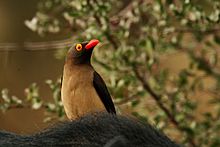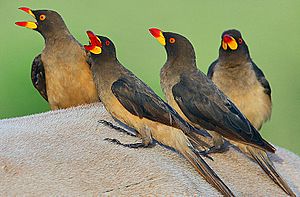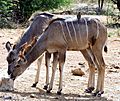Oxpecker facts for kids
Quick facts for kids Oxpeckers |
|
|---|---|
 |
|
| Red-billed Oxpecker | |
| Scientific classification | |
| Kingdom: | |
| Phylum: | |
| Class: | |
| Order: | |
| Suborder: | |
| Family: |
Buphagidae
Lesson, 1828
|
| Genus: |
Buphagus
Brisson, 1760
|
| Species | |
|
Buphagus africanus |
|


Oxpeckers are two types of bird that belong to the Buphagidae family. These birds live only in the savanna areas of Sub-Saharan Africa.
Their name comes from their special habit: they often sit on large mammals, like cattle or rhinoceroses. While perched, they eat ticks, botfly larvae, and other tiny creatures that live on the mammals.
Scientists have studied oxpeckers and found that they are an ancient group of birds. They are related to mockingbirds and starlings, but not very closely. It's thought that oxpeckers might have first appeared in Eastern or Southeastern Asia, making them a bit like living fossils!
Contents
What Do Oxpeckers Eat?
Oxpeckers eat only from the backs of large mammals. They seem to prefer certain animals, while avoiding others like the Lichtenstein's hartebeest or topi. The smallest animal they regularly use is the impala. This is probably because impalas often have many ticks and live in groups.
Today, oxpeckers often feed on cattle in many areas. However, they usually stay away from camels. They mostly eat tiny creatures that live on the skin of mammals, especially ticks. They also eat insects found in wounds and even drink blood from some wounds.
Are Oxpeckers Helpful or Harmful?
The relationship between oxpeckers and the mammals they sit on is a topic scientists are still studying. People once thought it was a perfect example of mutualism. This means both the bird and the mammal would help each other.
However, newer studies suggest that oxpeckers might sometimes be more like parasites. While they do eat ticks, they often eat ticks that have already fed on the mammal. There isn't clear proof that oxpeckers always reduce the number of ticks on an animal.
But one study on impalas showed something interesting. Impalas that had oxpeckers on them spent less time grooming themselves. This might mean they had fewer parasites. On the other hand, oxpeckers have been seen making new wounds or making existing ones worse just to drink blood. They also eat earwax and dandruff from mammals. Scientists think this might also be a parasitic behavior.
Some animals don't like oxpeckers on them. Elephants and some types of antelope will try to shake the oxpeckers off. Other animals tolerate them, even when the oxpeckers search for ticks on their faces. This can look uncomfortable for the mammal!
Oxpeckers as Rhino Guards
In the Swahili language, the word for oxpecker is "Askari wa kifaru." This means "the rhino's guard" in English. This name makes you wonder if oxpeckers really do help protect rhinos.
Scientists from California State University and Victoria University in Australia looked into this. They found that the black rhinoceros actually listens for the sounds oxpeckers make. Rhinos don't see very well, but oxpeckers have excellent eyesight.
When an oxpecker sees a human, it makes a special noise. It doesn't make this noise at any other time. Rhinos hear this sound and then either look for the human or run away.
The scientists did an experiment. A human would slowly walk towards a rhino. Rhinos without oxpeckers on their backs only noticed the human one out of five times. But rhinos with oxpeckers noticed the human every single time! They also noticed the human from much further away. This research suggests that bringing oxpeckers to rhino groups might help protect rhinos from human hunters.
Images for kids
-
Red-billed oxpeckers on female greater kudu.
-
Yellow-billed oxpecker on a wildebeest
-
Clutch of red-billed oxpeckers in a nest lined with impala hair, Kenya





